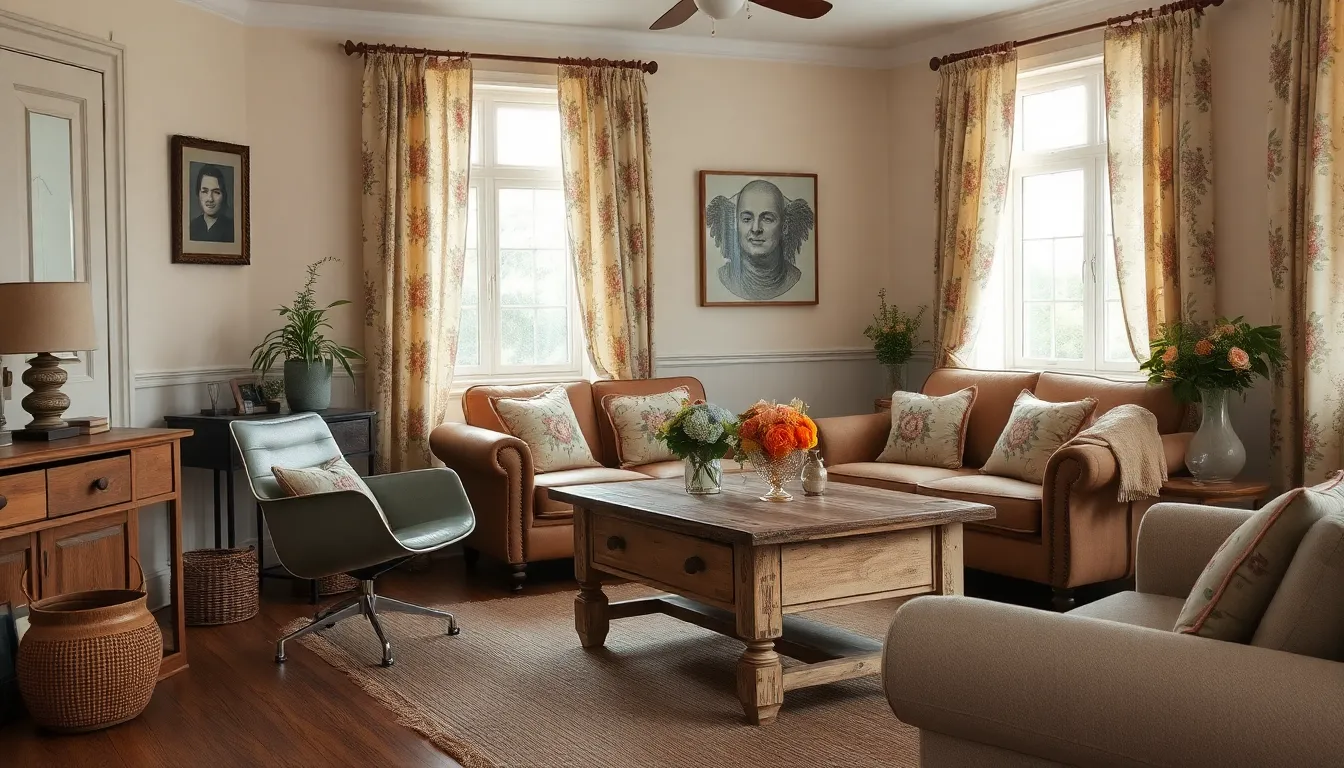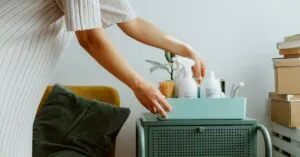Table of Contents
ToggleVintage decor brings a unique charm that transforms any space into a nostalgic haven. With its rich history and timeless appeal, it offers a glimpse into the past while adding character to modern living. From antique furniture to retro accessories, vintage elements create a warm and inviting atmosphere that resonates with many.
In an era where mass production dominates, vintage decor stands out as a celebration of individuality and craftsmanship. Each piece tells a story, making it not just decor but a conversation starter. Whether it’s a mid-century modern chair or a classic art deco lamp, these treasures infuse personality and style into homes, reminding us of the beauty in things that age gracefully. Embracing vintage decor allows one to curate a space that reflects personal taste and a love for history.
What Is Vintage Decor?
Vintage decor refers to interior design elements sourced from the past, typically between 20 and 100 years old. This style reflects a commitment to craftsmanship and aesthetic that often surpasses modern mass-produced items. Vintage decor encompasses an array of items, including furniture, art, and accessories, each contributing to a distinct historical narrative.
Key characteristics of vintage decor include:
- Timelessness: Vintage pieces often possess an enduring allure, making them staples in interior design.
- Uniqueness: Each item carries its individual history, offering a personal touch compared to contemporary items.
- Eclecticism: Vintage decor allows for diverse styles, integrating various historical periods and design philosophies within the same space.
Homeowners and decorators often gravitate toward vintage decor to create spaces filled with character and warmth. This style invokes nostalgia while showcasing personal expression, allowing individuals to curate unique environments that tell stories through their vintage finds. Functions of vintage decor extend beyond aesthetics, encouraging appreciation for history and craftsmanship within modern settings.
Elements of Vintage Decor

Vintage decor encompasses a variety of distinctive elements that contribute to its unique charm and character. These elements combine to create a cohesive aesthetic that reflects personal style and historical appreciation.
Furniture Styles
Furniture styles play a crucial role in establishing the vintage look in a space.
- Mid-Century Modern: This style features clean lines, organic shapes, and functional form. Iconic pieces include Eames chairs and teak sideboards.
- Art Deco: Characterized by bold geometric patterns and luxurious materials, Art Deco furniture often incorporates chrome and glass elements.
- Shabby Chic: This style combines elegance with a weathered feel, incorporating distressed furniture pieces, such as painted wooden tables and vintage armoires.
- Victorian: Heavy, ornate pieces made from dark woods, like mahogany, highlight craftsmanship and intricate detailing, common in Victorian-era furniture.
Color Palettes
Color palettes significantly influence the atmosphere of vintage decor.
- Muted Tones: Soft hues like pastel pinks, greens, and blues create an inviting, nostalgic ambiance.
- Rich Earthy Colors: Deep browns, forest greens, and burnt oranges evoke warmth and connect to historical styles.
- Bold Contrasts: In certain vintage styles, striking contrasts, such as black and gold or navy and white, emphasize sophistication and drama.
Textiles and Patterns
Textiles and patterns add texture and interest to vintage decor.
- Floral Prints: Traditional floral motifs on fabrics invoke a sense of nostalgia and softness, commonly used in upholstery and curtains.
- Plaids and Stripes: Classic plaid and striped patterns add a timeless charm, often seen in cushions and throws.
- Lace and Embroidery: Delicate lace details and rich embroidery enhance elegance, frequently used in table linens and window treatments.
By blending these elements—furniture styles, color palettes, and textiles—vintage decor creates spaces that reflect individuality and evoke historical appreciation.
Popular Vintage Decor Trends
Vintage decor trends reflect diverse styles that emphasize nostalgia and individuality. Key movements in this category, such as Mid-Century Modern and Shabby Chic, showcase the unique characteristics that make vintage pieces desirable.
Mid-Century Modern
Mid-Century Modern decor exudes simplicity and functionality, featuring clean lines, organic forms, and vibrant colors. This style emerged between the 1940s and 1960s, prioritizing open spaces and integrating indoor and outdoor living. Iconic furniture pieces include Eames lounge chairs and Danish teak sideboards. Decor elements often highlight materials such as molded plastic, plywood, and metal, enhancing the modern aesthetic. Popular colors, like mustard yellow, avocado green, and teal, contribute to the playful yet sophisticated vibe of this trend.
Shabby Chic
Shabby Chic decor combines elegance with a rustic charm, emphasizing comfort and coziness. This style highlights distressed furniture, soft color palettes, and vintage fabrics. Originating in the 1980s, Shabby Chic includes antique pieces often layered with floral prints, lace, and soft textures. Key characteristics involve a mix of weathered furniture, like whitewashed dining tables and oversized armchairs, creating a relaxed atmosphere. The use of pastel colors, such as blush pink and powder blue, further enhances the romantic feel of Shabby Chic spaces.
How to Incorporate Vintage Decor in Your Home
Integrating vintage decor into a home enhances character and personal expression. Here are effective strategies for sourcing vintage pieces and blending them with modern decor.
Sourcing Vintage Pieces
Sourcing vintage pieces involves seeking unique items that resonate with personal style. Here are common sources:
- Thrift Stores: Find hidden gems in local thrift shops that offer affordable vintage items.
- Antique Markets: Explore antique markets for a wide range of vintage furniture, decorative pieces, and artwork.
- Estate Sales: Attend estate sales to discover authentic vintage items often sold for reasonable prices.
- Online Marketplaces: Browse platforms like eBay, Etsy, and Facebook Marketplace for curated vintage selections.
- Flea Markets: Visit flea markets for a variety of vendors selling unique vintage finds.
Prioritize quality and condition when acquiring vintage pieces, ensuring they add both style and history to a space.
Mixing Vintage with Modern Decor
Mixing vintage with modern decor creates a balanced and interesting aesthetic. Consider these techniques:
- Select Key Accents: Choose a few standout vintage items as focal points in modern spaces, such as a vintage armchair or a classic lamp.
- Create Contrast: Pair sleek modern furniture with vintage textiles or accessories, adding warmth and depth to the design.
- Layering Styles: Incorporate various vintage styles, like art deco with minimalist modern, to provide eclectic charm without overwhelming a room.
- Use Color Palettes: Match vintage colors with modern elements to create a cohesive look. Soft pastel tones or bold jewel shades can bridge the two styles effectively.
- Balance Proportions: Ensure proportional balance by mixing oversized vintage furniture with smaller modern pieces, maintaining an inviting flow.
By thoughtfully sourcing vintage items and skillfully blending them with modern decor, homeowners create unique spaces that reflect individuality and history.
Embracing vintage decor offers a unique opportunity to infuse spaces with character and charm. It allows individuals to showcase their personal style while celebrating the craftsmanship of the past. By thoughtfully selecting vintage pieces and blending them with modern elements, homeowners can create inviting atmospheres that tell a story.
The timeless appeal of vintage decor lies in its ability to evoke nostalgia and highlight individuality. Whether it’s a mid-century modern chair or a shabby chic lamp, each item adds a layer of depth to the overall design. As more people seek to break away from mass production, vintage decor remains a beloved choice for those looking to create distinctive and meaningful environments.




